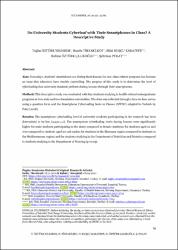| dc.contributor.author | Öztürk Yıldırım, Tuğba | |
| dc.contributor.author | Tiryaki Şen, Hanife | |
| dc.contributor.author | Kuşçu Karatepe, Hilal | |
| dc.contributor.author | Öztürk Çalıkoğlu, Halime | |
| dc.contributor.author | Polat, Şehrinaz | |
| dc.date.accessioned | 2023-07-12T15:02:34Z | |
| dc.date.available | 2023-07-12T15:02:34Z | |
| dc.date.issued | 2022 | en_US |
| dc.identifier.issn | 2536-4499 | |
| dc.identifier.issn | 2602-2605 | |
| dc.identifier.uri | https://hdl.handle.net/11363/5007 | |
| dc.description.abstract | Aim: Nowadays, students' smartphone use during their lessons for non-class-related purposes has become
an issue that educators have trouble controlling. The purpose of this study is to determine the level of
cyberloafing that university students perform during lessons through their smartphones.
Method: This descriptive study was conducted with 892 students studying in health-related undergraduate
programs at two-state and two foundation universities. The data was collected through a face-to-face survey
using a question form and the Smartphone Cyberloafing Scale in Classes (SPCSC) adapted to Turkish by
Polat (2018).
Results: The smartphone cyberloafing level of university students participating in the research has been
determined to be low (2,33±1,11). The smartphone cyberloafing levels during lessons were significantly
higher for male students participating in the study compared to female students; for students aged 21 and
over compared to students aged 20 and under; for students in the Marmara region compared to students in
the Mediterranean region; and for students studying in the Department of Nutrition and Dietetics compared
to students studying in the Department of Nursing (p<0.05).
Conclusion: The frequency of smartphone cyberloafing behavior in class is affected by gender, age,
geographical region, and the department of the students. This study provides educators with basic
knowledge to guide planning for effective teaching and learning settings. | en_US |
| dc.description.abstract | Amaç: Günümüzde öğrencilerin akıllı telefonlarını ders sırasında ders dışı amaçlarla kullanmaları
eğiticilerin kontrol etmekte zorlandıkları bir konu haline gelmiştir. Bu çalışmanın amacı, üniversite
öğrencilerinin ders esnasında akıllı telefon üzerinden gerçekleştirdikleri siber aylaklık düzeylerini
belirlemektir.
Yöntem: Tanımlayıcı türdeki bu araştırma iki devlet ve iki vakıf üniversitesinde sağlıkla ilgili lisans
programlarında öğrenim gören 892 öğrenci ile yürütülmüştür. Veriler, Soru Formu ve Polat (2018)
tarafından Türkçe’ye uyarlanan Derslerde Akıllı Telefon Siber Aylaklığı Ölçeği (DATSA) kullanılarak yüzyüze
anket tekniği ile toplanmıştır.
Bulgular: Araştırmaya katılan üniversite öğrencilerinin derslerde akıllı telefon siber aylaklığı düzeylerinin
düşük (2,33 ± 1,11) olduğu belirlenmiştir. Çalışmaya katılan kadın öğrencilerin erkek öğrencilere; 21 ve üzeri
yaşa sahip öğrencilerin 20 ve altı yaşa sahip öğrencilere; Marmara bölgesinde okuyan öğrencilerin Akdeniz
bölgesinde okuyan öğrencilere; Beslenme ve Diyetetik bölümünde okuyan öğrencilerin Hemşirelik
bölümünde okuyan öğrencilere göre derslerde akıllı telefon siber aylaklığı düzeyleri anlamlı şekilde yüksek
bulunmuştur (p<0,05).
Sonuç: Derste akıllı telefonla sanal aylaklık davranışının sıklığı cinsiyet, yaş, coğrafi bölge ve öğrencilerin
okudukları bölümden etkilenmektedir. Bu çalışma, etkili öğretme ve öğrenme ortamlarına yönelik
planlamalara yol göstermesi bakımından eğiticilere temel bir bilgi sağlar. | en_US |
| dc.language.iso | eng | en_US |
| dc.publisher | İstanbul Gelişim Üniversitesi Yayınları / Istanbul Gelisim University Press | en_US |
| dc.relation.isversionof | https://doi.org/10.38079/igusabder.1041336 | en_US |
| dc.rights | info:eu-repo/semantics/openAccess | en_US |
| dc.rights | Attribution-NonCommercial-NoDerivs 3.0 United States | * |
| dc.rights.uri | http://creativecommons.org/licenses/by-nc-nd/3.0/us/ | * |
| dc.subject | Cyberloafing | en_US |
| dc.subject | smartphone | en_US |
| dc.subject | students | en_US |
| dc.subject | Siber aylaklık | en_US |
| dc.subject | akıllı telefon | en_US |
| dc.subject | öğrenciler | en_US |
| dc.title | Do University Students Cyberloaf with Their Smartphones in Class? A Descriptive Study | en_US |
| dc.title.alternative | Üniversite Öğrencileri Derste Akıllı Telefonla Siber Aylaklık Yapıyor mu?: Tanımlayıcı Bir Çalışma | en_US |
| dc.type | article | en_US |
| dc.relation.ispartof | İstanbul Gelişim Üniversitesi Sağlık Bilimleri Dergisi | en_US |
| dc.department | İstanbul Gelişim Üniversitesi | en_US |
| dc.authorid | https://orcid.org/0000-0002-6853-8996 | en_US |
| dc.authorid | https://orcid.org/0000-0003-3350-1701 | en_US |
| dc.authorid | https://orcid.org/0000-0001-9237-2714 | en_US |
| dc.authorid | https://orcid.org/0000-0003-0121-7124 | en_US |
| dc.authorid | https://orcid.org/0000-0002-1884-897X | en_US |
| dc.identifier.issue | 16 | en_US |
| dc.identifier.startpage | 75 | en_US |
| dc.identifier.endpage | 86 | en_US |
| dc.relation.publicationcategory | Makale - Ulusal Hakemli Dergi - Başka Kurum Yazarı | en_US |



















